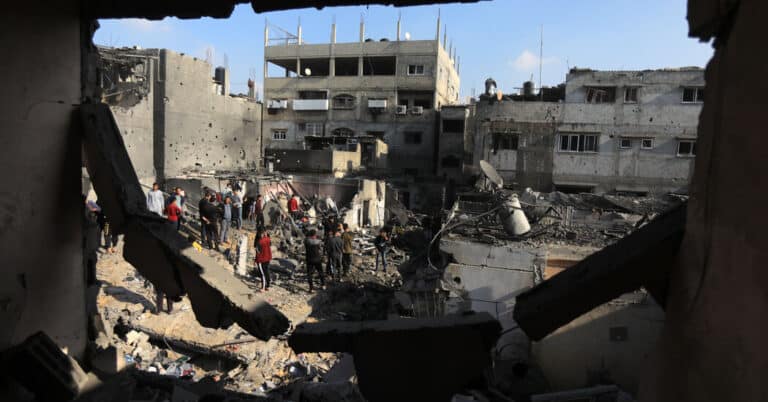Much of Gaza lies in ruins, with its people pushed from their homes by Israeli bombardment and the death toll climbing ever higher. On the ground, Hamas, which has ruled Gaza for 16 years, has largely vanished, other than when its fighters pop up to attack Israeli tanks or fire rockets at Israel.
But the group is still reaping benefits from its surprise attack on Israel on Oct. 7. It is regarded as the only Palestinian faction to squeeze concessions from Israel in many years. It has thrown a bloody wrench into Israel’s plans to improve relations with its Arab neighbors and forced the Palestinian issue back onto the agendas of world leaders.
Two months into the war, despite vows by Israeli officials to destroy Hamas, Israel has yet to kill its top leaders, free the remaining 137 hostages Hamas holds or provide convincing evidence that it can achieve its goal of eliminating Hamas without an astronomical human cost.
In Hamas’s cynical calculation, the loftiness of Israel’s aims is a plus. While sticking to its long-term goal of destroying the Jewish state, Hamas can declare victory merely by surviving to fight another day.
“There is always going to be an advantage that an unconventional force will have, particularly if it is as ruthless as Hamas and doesn’t really care about the damage to the local civilians,” said Ahmed Fouad Alkhatib, a Middle East policy analyst who grew up in Gaza. “Israel is going to be stuck in this unwinnable war, causing massive death and destruction.”
What exactly Israel can achieve remains an open question. But simply prosecuting the war can, over time, damage Israel’s economy and international standing, while encouraging a new generation of Palestinians to hate Israel — all benefits for Hamas.
The Hamas-led surprise attack on Oct. 7 was the deadliest day in Israel’s history, with about 1,200 people, mostly civilians, killed and 240 taken captive. Israel responded with a military ferocity not seen anywhere in decades, dropping thousands of bombs on Gaza and launching a ground invasion aimed at destroying Hamas’s military and governing structures.
The war has been catastrophic for Gaza’s 2.2 million people. About 85 percent have fled their homes and now face a growing challenge to find food, water, shelter and medical care. More than 15,000 people have been killed, more than two-thirds of them women and children, according to the territory’s health authorities, who do not report how many of the dead were combatants.
The war has taken a toll on Hamas, too. The group has largely abandoned governance in Gaza, although remnants of its police force still work in the south, and medics in hospitals overseen by the Health Ministry struggle to treat floods of wounded patients. Otherwise, it is increasingly leaving the strip’s people to fend for themselves.
Israel has blown up many of the tunnels that Hamas has built over the years to covertly move around the territory, hold captives, manufacture weapons and plan attacks.
Hamas is estimated to have 25,000 fighters, and Israeli officials assess that a few thousand of them have been killed in Gaza, in addition to about 1,000 inside Israel on Oct. 7. Both Israel and Hamas have announced the names of Hamas military figures killed in the war. On Thursday, Israel published a photograph it said showed 11 Hamas commanders meeting in a bunker. Five of them were marked with red circles that read, “Eliminated.”
But fighters from Hamas and other armed factions continue to attack Israeli forces inside Gaza and have killed more than 90 soldiers since the start of Israel’s ground invasion, including the son of Israel’s former chief of staff.
Israel has yet to find and kill Hamas’s top leaders in Gaza, including Yahya Sinwar, the highest ranking Hamas official in the territory, and Mohammed Deif, who leads the group’s armed wing. Israel considers both men architects of the Oct. 7 assault and of the fighting in Gaza since.
Mr. Sinwar has not appeared publicly since the war began. But one hostage, Yocheved Lifshitz, an 85-year-old peace activist, told an Israeli newspaper after her release last month that Mr. Sinwar had come to the tunnel where she was being held. She said she asked him if he was ashamed to have done such a thing to people who had supported peace. Mr. Sinwar did not answer, she said.
Coordination continues between Hamas members in and outside of Gaza, which allowed leaders based in Qatar to negotiate exchanges of hostages for prisoners that Hamas in Gaza then carried out. The group’s media teams churn out news updates, statements from leaders and videos of attacks and civilians killed in Israeli strikes. Hamas officials in Turkey and Lebanon communicate their views to journalists and diplomats, and the group’s leaders in Qatar speak regularly with mediators from Qatar and Egypt about potential cease-fires and exchanges of captives.
In Hamas’s view, he said, “This is the necessary first step to reverse the strength that Israel gets from being integrated into the region and the world.”
There are also scant historical examples of Israel successfully using overwhelming force to destroy its enemies.
In 1982, Israel invaded Lebanon to destroy the Palestine Liberation Organization, which it considered a terrorist organization. The war was long and deadly and failed to destroy the P.L.O., while preparing the ground for…


